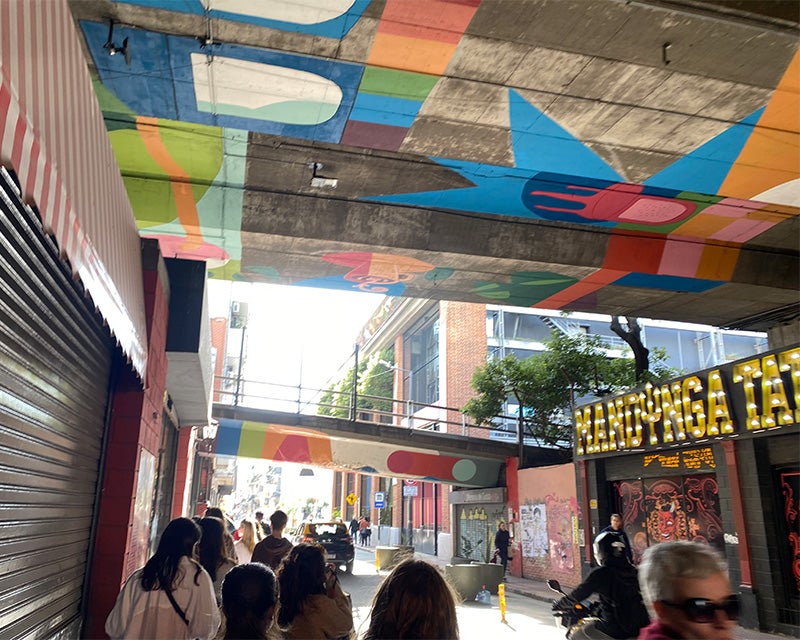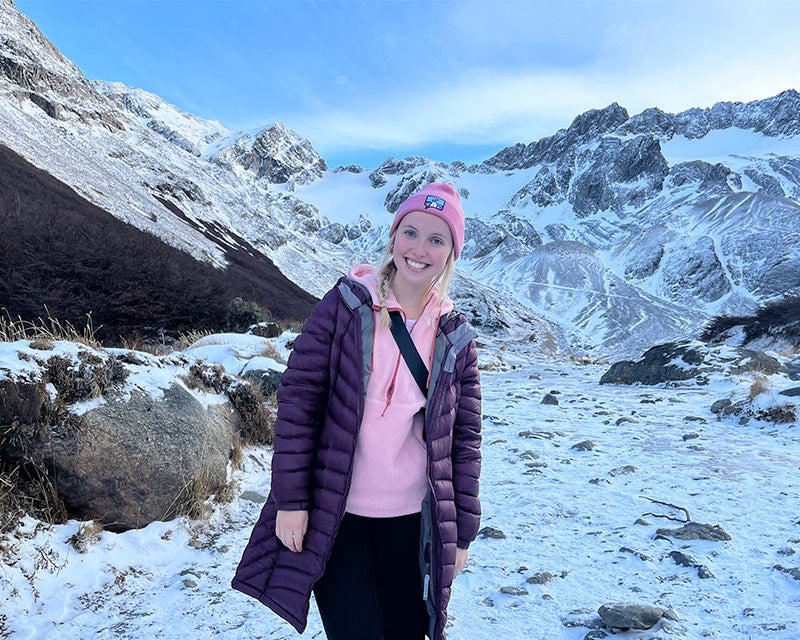From Cells to the Clinic: School of Health Undergraduates in Argentina Study Respiratory Diseases
(August 4, 2023) — School of Health students immersed themselves in the Argentinian health care system as part of a six-week translational health science internship program to study the clinical effects and molecular mechanisms of viruses that cause respiratory infections in infants and children.
This summer, 15 students studied respiratory syncytial virus (RSV) “from bench to bedside” — starting with lectures by established virologists, progressing to studying viral infections of cell cultures in a laboratory setting, and ending with shadowing Argentinian physicians in pediatric hospitals.

Students explored the colorful streets of Buenos Aires.
Students also explored Buenos Aires and took weekend trips to nearby countries.
“The program is pretty unique in that there are not many study abroad programs that are a science class that allows you to do research in a lab,” said Pablo Irusta, PhD, associate professor and chair of the Department of Human Science and internship program director. “You also don’t have to be proficient in Spanish to take part, although students have the opportunity to take informal Spanish classes.”
Classroom Before Cell Cultures
“In the classroom, the students receive lectures explaining the basic mechanisms of pathogens that cause respiratory disease and how our bodies use the immune system to defend themselves,” said Irusta. Physicians and researchers from the Universidad Nacional de San Martin (UNSAM) instructed the students throughout the internship.
Studies show that RSV, also common in the U.S., is the most frequent cause of lower respiratory tract infections in children. While detection was significantly lower during COVID mitigation strategies in 2020, the virus began reemerging later in 2021.
“Understanding the basics of how respiratory illness operates in Argentina and the research that had already been done on the viruses was very helpful to all of us at the start of the program,” said Sabreen Mohammed (H’24), a global health major.
“In lecture, we learned about the effects RSV has on children, not only symptoms and how the illness progresses, but also on the cellular level,” said Charlotte Samuelson (H’24), a human science major. “We also had lectures on the Argentinian health care system.”
“Each lecture was unique and focused on a different topic that helped us prepare for the labs and clinics,” Samuelson added.
A Team Approach to Care

An X-ray of a child with RSV; arrows point to inflammation typical of the disease. (Image: James Heilman, MD, Wikipedia Commons)
Samuelson, who plans to go to medical school, found the clinical shadowing opportunities especially valuable.
“In Argentina, it’s winter right now so it’s cold and flu season, which allows us to see cases of RSV in the clinics,” she said. “We visited different health care centers every week, from pediatric outpatient offices to hospitals, and saw a lot of children with RSV symptoms.”
Students shadowed physicians as they evaluated patients and took part in provider meetings discussing patients’ medical charts and evaluations.
“I had such an English-centered view of medicine before this experience,” Mohammed said. “I just assumed the word for thorax would be the same in Spanish, but there’s a specific medical term in Spanish for everything.”
“Something also clicked for me when I finally got to hear what crackle sounded like in the lungs,” said Mohammed. Crackle is a sound detected in the lungs that is a sign of RSV. “It was remarkable to hear, but you are also in the room with patients who are struggling to breathe.”
“RSV can be terrifying,” said Mohammed. “Parents can be hysterical watching their children struggle.”
After meeting with the patient and their family, students stepped out of the room and took part in provider team meetings.
“The provider team meetings and the amount of communication between physicians is one difference I noticed between the United States and Argentinian health care systems,” said Mohammed.
“In the U.S., you usually have one doctor in the room and maybe an attending somewhere on-site, but at the clinics there were six physicians, including residents, in the room at a time,” said Mohammed. “I also noticed there weren’t a lot of nurses present in the clinics. It was the doctors spending all of the time with the patients.”
Samuelson also observed differences between the Argentinian public health care system and the United States.
“With Argentina’s public system, I noticed there were families waiting everywhere at the clinics,” said Samuelson. “The care is free, but there are longer wait times. There’s also not the same level of advertising for health care like in the United States, where you see billboards for insurers.”
Lab Projects
Students participated in labs studying viral infections in cell cultures throughout the six weeks.
“We learned and practiced lab techniques, including being given a small sample of RSV and running it through a PCR machine to see if it’s positive,” said Mohammed.
Samuelson described additional lab work involving injecting cell cultures with various RSV strains and then studying the effects of what happened to the cells.
Students were also assigned a research question to address in a final project on which they have a group presentation. Mohammed was tasked with studying what epidemiological factors impact fatal developments of RSV.
“We looked at a range of risk factors, including if oxygen was administered at birth, if the infant’s family smoked or had pets,” said Mohammed. “One of the factors we found that had an increased risk was having to ventilate the child’s thorax during hospital visits.”
Weekend Trips

During her internship, Charlotte Samuelson visited Patagonia.
When not in a classroom, lab or clinic, students explored the culture of Buenos Aires and beyond.
“Buenos Aires is such a big city, and I’ve been traveling to different neighborhoods and getting a feel for the city,” said Samuelson. “A group of us also went to a professional football match, which was great to experience with all of the fans.”
Samuelson also visited Patagonia on the southern tip of South America, where she hiked glaciers and saw penguins and seals.
“We all took a trip to the Iguazu Falls on the border of Brazil and Argentina,” said Mohammed. “I saw a rainbow at the end of the waterfall and a toucan. It was very beautiful.”
“The entire time we’ve been in Argentina, whether it’s experiencing the culture, the food or seeing the differences in health care, it’s been constantly learning new information and perspectives,” said Samuelson. “Especially as someone who wants to go to medical school and become a doctor, I feel like I’ve learned so much about health care in the U.S. by seeing how things are done in Argentina.”
Heather Wilpone-Welborn
GUMC Communications
Top Image: A group of the students at a public outpatient pediatric office, one of the clinical shadowing sites: (pictured from left) Charlotte Samuelson, Nick Cohen, a doctor at the site, Anisha Patibandla, Irene Chang, and another doctor.

